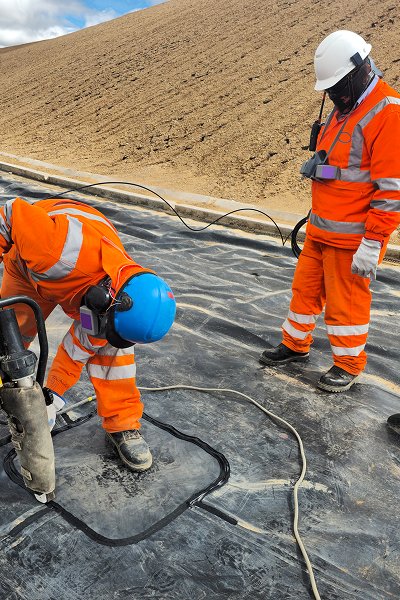What is Composite Geonet?
Composite Geonet is a structural drainage material composed of multiple layers of geosynthetics. It usually uses a three-dimensional plastic geonet as the core layer, and covers one or more layers of geotextile (non-woven or woven) above and below it, which is compounded by hot pressing or bonding process. It integrates drainage, filtration, anti-seepage and reinforcement functions, and is widely used in engineering fields such as slope protection, tunnel drainage, landfills, dams, etc.


Structural composition of composite geonet
The composite geonet is mainly composed of three parts, and each layer has its function and role:
Core layer: three-dimensional plastic geonet (drainage net core)
Generally made of **HDPE (high-density polyethylene)** material;
The structure includes Y-type, three-layer mesh, butterfly type, etc.;
The middle layer has large gaps, stable structure, and strong compressive resistance;
Main function: efficient water conduction and drainage.
Surface layer: geotextile (filtration/protective layer)
The material is mostly polypropylene (PP) or polyester (PET);
It can be non-woven fabric (needle punched or hot rolled) or woven fabric;
The upper and lower fabric layers can prevent fine soil particles from entering the drainage core layer, playing a filtering and protective role;
It also has a certain protection and reinforcement capacity.
Binding layer: adhesive or hot melt layer
The core layer and geotextile are tightly combined through hot pressing, extrusion compounding, needle punching compounding and other processes;
It requires strong bonding and high peeling strength to prevent delamination caused by construction or long-term stress.

Key points for material selection
Core Geonet Material
Preferred material: High-density polyethylene (HDPE)
Reasons for selection:
High pressure resistance: Suitable for drainage under long-term load conditions;
Chemical corrosion resistance: Can resist common chemicals such as acids, alkalis, and salts;
Good flexibility and crack resistance: Adapt to terrain changes;
Strong weather resistance: Anti-aging, suitable for underground or exposed environments.
Geotextile Layers (Filter Fabrics)
Common Materials: Polypropylene (PP) or Polyester (PET)
| Property | PP Nonwoven Fabric | PET Nonwoven Fabric |
|---|---|---|
| Filtration precision | High | High |
| Tensile strength | Moderate | High |
| Chemical resistance | Excellent | Very good |
| Temperature resistance | Up to 90°C | Up to 120°C |
| Cost | Relatively lower | Slightly higher |
Functional Additives (Optional Enhancements)
| Additive | Function | Typical Application |
|---|---|---|
| Carbon black | UV resistance | Outdoor or shallow-buried uses |
| Antioxidants | Aging and oxidation resistance | High-heat or reactive soils |
| Flame retardants | Fire protection | Tunnel or electrical projects |
| Plasticizers | Improve flexibility | Uneven terrain or tight curves |
Core functions of composite geonet
Horizontal drainage capability
The three-dimensional plastic mesh core forms a stable drainage channel, which can maintain good drainage function even under pressure, and is suitable for vertical or horizontal drainage systems.
Filtration and anti-clogging effect
The upper and lower geotextiles can effectively prevent fine particles from entering the drainage core layer with the water flow, prevent blockage, and keep water seepage unobstructed.
Reinforcement and anti-scouring
The composite structure increases the overall tensile strength and in-plane stability of the material, and can be used for structural support purposes such as slope protection, soft foundation treatment, and drainage behind retaining walls.
Decompression and protection
As the upper protective material of the anti-seepage layer or structural layer, the composite geonet can effectively disperse the load and reduce the local stress concentration of the membrane or pipeline.


